Have you ever dreamed of visiting Italy, witnessing magnificent architectural wonders firsthand, and capturing memorable “check-in” moments at one of the world’s most unique landmarks? The Leaning Tower of Pisa is a must-visit destination on your journey to explore beautiful Italy. More than just an architectural icon with its “one-of-a-kind” tilt, the Leaning Tower of Pisa also holds a fascinating story of history and culture. Join “Du lịch khắp thế gian” (Travel Around the World) to discover everything about the Leaning Tower of Pisa and pocket unique “check-in” tips to get millions of likes on your photos!
Ideal Time to Check-in at the Leaning Tower of Pisa
Italy is a beautiful country with a mild and pleasant climate throughout the year. However, to have the most complete “check-in” experience at the Leaning Tower of Pisa, you should choose the appropriate travel time.
Spring (March – June) and autumn (September – mid-December) are considered the two best periods to visit Pisa. At this time, the weather in Italy is extremely pleasant, the sky is clear blue, the sun is gentle, very suitable for sightseeing, outdoor exploration, and especially “hunting” for shimmering check-in photos at the leaning tower.

Summer (June – September) in Italy is quite hot, especially in July and August, temperatures can reach 35-40 degrees Celsius. However, this is also the peak tourist season in Pisa, with a large number of visitors. If you don’t mind the hot weather and want to immerse yourself in the bustling and vibrant atmosphere, summer is still an option.
Winter (December – mid-March of the following year) in Italy is quite cold, especially in the North. Pisa is no exception; temperatures can drop low and there may be snowfall. However, the Leaning Tower of Pisa covered in white snow also has its own unique, romantic, and unique beauty. If you love winter and want to experience a more peaceful and deserted Pisa, winter is also a good suggestion.
Directions to the Leaning Tower of Pisa from Vietnam and Major Italian Cities
To get to the Leaning Tower of Pisa, you first need to travel to Italy. Currently, many airlines operate routes from Vietnam to major Italian cities such as Rome, Milan, and Florence. You can choose direct or connecting flights depending on your budget and time.
Once in Italy, you can travel to Pisa by various means:
From Florence:
Florence is the closest city to Pisa and is also a popular destination for tourists who want to visit the leaning tower. The most convenient and fastest way to get from Florence to Pisa is by train.
The train journey from Florence to Pisa takes only about 1 hour. The train will take you to Pisa Centrale station. From the train station, you can walk for about 20 minutes or take a bus or taxi to reach the leaning tower area.
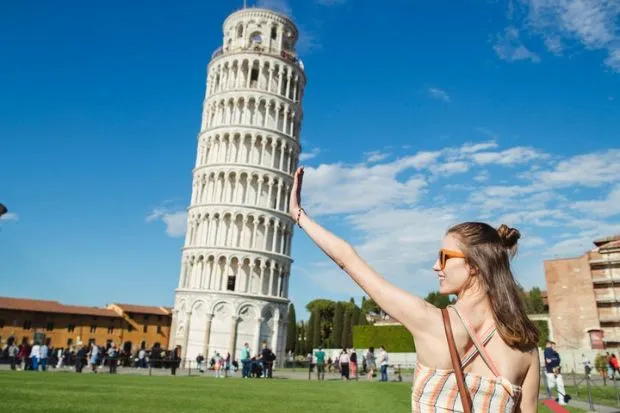
From Rome or other cities:
If you are in Rome or other Italian cities, you can also easily reach Pisa by train or long-distance bus. Travel time will depend on the distance and the means of transport you choose.
Getting around Pisa city:
Once you arrive in Pisa, getting to the leaning tower is very easy. From Pisa Centrale station, you can walk for about 20 minutes along Viale Antonio Gramsci or Viale Francesco Crispi to Piazza dei Miracoli, where the Leaning Tower of Pisa is located.
In addition, you can also choose public transport such as buses or taxis for faster travel. However, walking is still an enjoyable experience, helping you discover the beauty of Pisa city along the way.
Check-in and Explore the Leaning Tower of Pisa Complex
The Leaning Tower of Pisa does not stand alone but is part of the Campo dei Miracoli (Miracle Square) religious architectural complex, world-renowned. This complex includes:
1. Leaning Tower of Pisa: Symbol of Uniqueness
The Leaning Tower of Pisa, or Torre pendente di Pisa in Italian, is a unique and most famous architectural work of the Campo dei Miracoli complex. The tower was started in 1173 with the initial purpose of being a bell tower for the Pisa Cathedral (Duomo).
However, right from the construction up to the third floor in 1178, the tower began to lean due to the soft ground. Nevertheless, construction continued and it took nearly 200 years, until 1372, for the tower to be completed. This unusual tilt has turned the Leaning Tower of Pisa into a unique architectural symbol, attracting millions of tourists from all over the world to “check-in” every year.

The tower is 55.86 meters high from the ground on the low side and 56.67 meters on the high side, with 8 floors and a total of 294 spiral steps leading to the top of the tower. The architecture of the tower is deeply Romanesque, typical of the Pisa region, with delicate white stone columns and soft curves.
2. Duomo Cathedral: Ancient and Magnificent Beauty
The Duomo Cathedral, also known as the Cattedrale di Santa Maria Assunta, is the main cathedral of Pisa and the central building of the Campo dei Miracoli complex. The cathedral was built from 1064 to the 12th century, even before the Leaning Tower of Pisa.
The Duomo Cathedral is a Romanesque architectural masterpiece with a magnificent facade decorated with white and dark gray marble, along with intricate carvings. Inside the cathedral is a vast, solemn space with soaring granite columns, ancient frescoes, and valuable religious works of art.
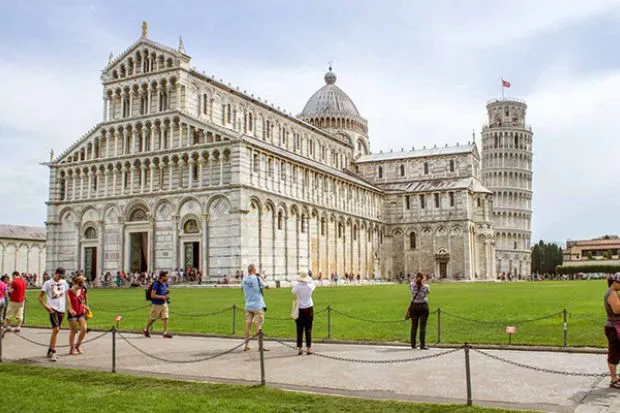
3. Baptistery: Cylindrical Architecture and Special Acoustics
The Pisa Baptistery (Battistero di San Giovanni) is a unique cylindrical architectural work, located opposite the Duomo Cathedral. The baptistery was built from 1152 to the 14th century, also in Romanesque and Gothic style.
The special feature of the Pisa Baptistery is its unique acoustics inside. Due to the double-dome structure, the sound in the baptistery has a very large echo. Every 30 minutes, the manager will perform a short “sound test”, creating magical echoing sounds, which tourists find very interesting.
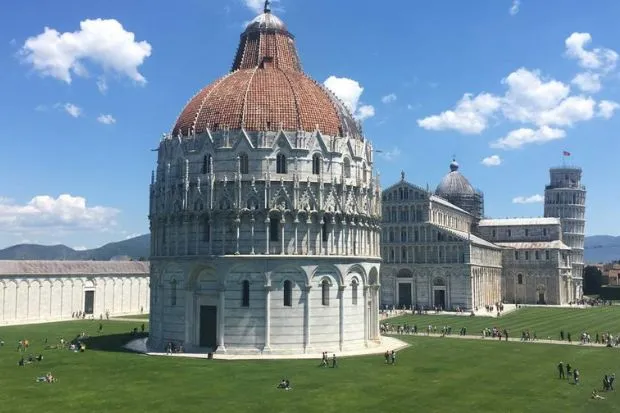
4. Camposanto Cemetery: Solemn and Artistic Space
The Camposanto Monumentale cemetery, also known as Camposanto Santo, is an ancient cemetery architectural work, located to the north of Piazza dei Miracoli. The cemetery was built from 1278 to the 15th century, surrounding a large rectangular courtyard.
Camposanto is not only the resting place of the people of Pisa but also an art museum with ancient frescoes, intricately carved stone tombs, and valuable sculptures. The solemn and quiet space of the cemetery brings visitors deep emotions and reflections on life.
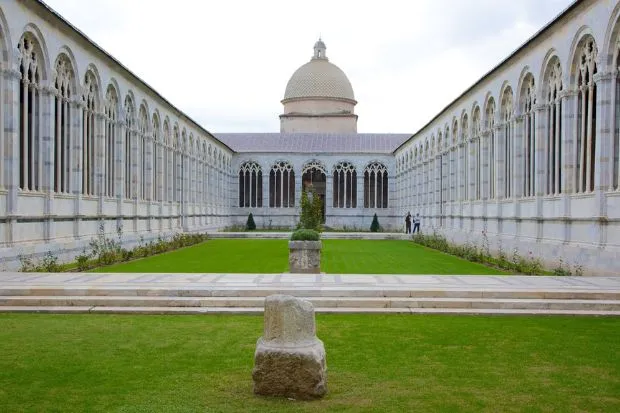
Tips for Check-in at the Leaning Tower of Pisa for Unique and Impressive Photos
Visiting the Leaning Tower of Pisa without unique “check-in” photos would be a major omission. Here are a few suggestions to get millions of likes on your photos:
- “Supporting the tower” pose: This is the classic and most popular pose when checking in at the Leaning Tower of Pisa. You can pretend to support the tower with your hands, push the tower, or even “pinch” the tower. Be creative and experiment with different angles to get humorous and impressive photos.
- “Climbing the tower” pose: Instead of just standing at the foot of the tower, try posing as if you are climbing the tower. You can lean in the opposite direction to the tower’s tilt, creating the feeling of trying to maintain balance.
- Use props: Bring small props such as hats, sunglasses, scarves, or even an Italian pizza to add highlights to your check-in photo.
- Take group photos: If you are traveling with friends or family, pose together and take fun and memorable group photos.
- Take photos at different times of the day: Sunlight will change over time during the day, creating different lighting effects for your photos. Try taking photos in the early morning, sunny noon, or sunset afternoon to get diverse and impressive photos.
Interesting and Little-Known Facts about the Leaning Tower of Pisa
Besides its unique tilt, the Leaning Tower of Pisa also hides many interesting and little-known facts:
- Not the only leaning structure in Pisa: Due to the geological characteristics of the Pisa region being soft, sinking soil, not only the Leaning Tower of Pisa but also some other structures in the city are leaning, such as the bell towers of the churches of San Nicola and San Michele degli Scalzi.
- Tilt changes over time: The tilt of the Leaning Tower of Pisa is not fixed but changes over time. Initially, the tower only tilted about 0.2 degrees. By 1990, the tilt had reached 5.5 degrees, causing many to worry that the tower would collapse. After many reinforcement efforts, the current tilt of the tower has been reduced to about 3.97 degrees and is considered stable.
- Associated with scientist Galileo Galilei: The Leaning Tower of Pisa is also known as the place where scientist Galileo Galilei conducted experiments on gravity in the 16th century. He dropped two balls of different weights from the top of the tower to prove that the falling speed of an object does not depend on its weight.
- Symbol of prosperity: In the 12th century, Pisa was an independent and prosperous kingdom. The construction of the Leaning Tower of Pisa was seen as a way to show the wealth and power of the Kingdom of Pisa at that time.
- Tower bells silent for a century: The 7 bells on top of the Leaning Tower of Pisa have not rung for over a century. Due to concerns that the weight and vibration of the bells could further increase the tilt and endanger the tower, it was decided not to ring the bells anymore.
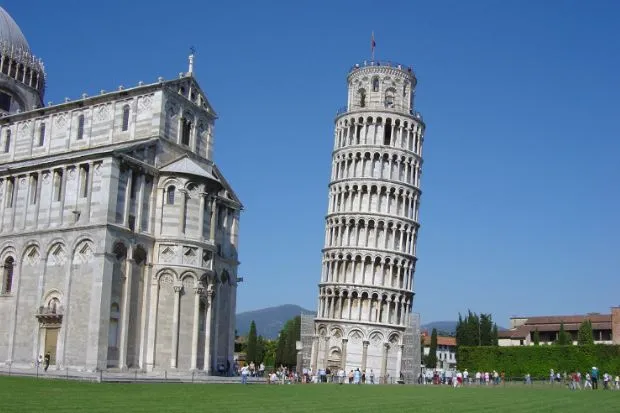
Important Notes When Checking in and Visiting the Leaning Tower of Pisa
To have a smooth and complete visit and check-in at the Leaning Tower of Pisa, you need to note a few things:
- Book tickets in advance: To visit inside the Leaning Tower of Pisa, you need to buy tickets online in advance on the official website of the Campo dei Miracoli complex. Tower tour tickets are limited in number and time, especially during peak tourist season, tickets often sell out very quickly.
- Choose appropriate visiting hours: You should choose visiting hours in the early morning or late afternoon to avoid the hot sun and crowds.
- Limited visiting time: The visiting time inside the Leaning Tower of Pisa is limited to about 30 minutes. Make the most of this time to explore and take photos.
- Luggage regulations: When entering the tower, you are only allowed to bring cameras, phones, and small camcorders. Other items such as handbags, backpacks, food, and drinks must be deposited in the cloakroom outside.
- Dress code: When visiting the Duomo Cathedral and other religious buildings in the complex, you should dress politely and discreetly. Avoid wearing revealing clothes, short skirts, or tank tops.
Conclusion: Leaning Tower of Pisa – A Must-Visit Check-in Destination in Italy
The Leaning Tower of Pisa is not only a unique architectural work but also a famous cultural, historical, and tourist symbol of Italy. With its “one-of-a-kind” tilt, magnificent Campo dei Miracoli architectural complex, and interesting stories hidden inside, the Leaning Tower of Pisa will surely bring you unforgettable “check-in” experiences and memorable memories on your journey to explore beautiful Italy. Don’t forget to plan and book your Leaning Tower of Pisa tour tickets today so you don’t miss the opportunity to admire this unique wonder!